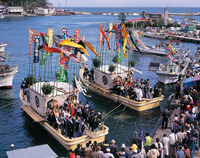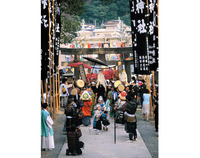

Total:35items

 |
|
 《Feature》
《Feature》Origin of the ritual
Aofushigaki Shinji is a ritual held at Miho shrine in Miho-Sekimachi on April 7th every year.
The ritual re-acts the mythology of "Kuniyuzuri" (transfer of the land of Izumo). The mythology says Kotoshironushi-no-mikoto (or Ebisu, known as one of seven Gods of fortune) who is the deity of Miho shrine, advised his father, Okuninushi-no-mikoto(or Daikoku, also one of the seven Gods), that he should transfer the land of Izumo to the descendant of the sun goddess.
After advising his father, Kotoshiro-no-mikoto made a blue brushwood fence (Aofushigaki) in the sea, and hid himself behind it. (In ancient Japanese language,to hide means to die).
Preparing for the ritual
"Toya" -a protagonist in Aofushigaki Shinji
One year before the ritual, protagonists of the ritual are determined. Two men appointed to "Toya" have to purify themselves and devote to the heavy mission.
The day before the ritual, two "Toya" who are applied white make-up on those faces with three red marks on their cheeks and foreheads seclude themselves in "Kakureden" (hiding place) in the shrine. They go on fast to empty themselves and become into a state of trance.
"Toya" is a person who serves to god. In Aofushigaki shinji, there are two "Toya".
"Ichi no Toya" (the first Toya) serves to Mihotsu-himenomikoto
"Ni no Toya" (the second Toya) serves to Kotoshiro-no-mikoto
"Toya" and his wife get on the boat together and sail around Miho bay. After sailing, both the first and the second "Toya" worship at Miho Shrine and offer "Hohei" (a wand with hemp and paper streamers) to the gods they serve. The boats are surrounded by 3.6m square fence made by cloth and poles made of Sakaki branch were placed on every corner. Originally, the fence was all made by Sakaki trees.
Miho Shrine
Miho shrine, located in the center of Mihonoseki city, is one of the oldest shrine with a unique style called "Miho style", which consists of two shrines, where two gods, Kotoshiro-nomikoto (the oldest son of "Okuninushi-nomikoto") and his mother Mihotsu-himenomikoto are worshipped.
Mythology of "Kuniyuzuri"
According to the mythology, Kotoshironomikoto (Ebisu) supported his father god, Daikoku in managing the country, and devoted himself to developing industry and establishing moral standards. One day, "Takemikazuchi-no- onokami", an emissary of Takamagahara (world of heaven) who went down to earth before "Tenson Kohrin" (the descent of the sun goddess Amaterasu's grandson "Ninigi" from heaven), visited Okuninushi-nomikoto to request that he should give the land of Izumo to the grandson of the sun goddess who was the original owner. Okuninushi-no-mikoto answered he had to talk to Kotoshiro-no-mikoto who lived in Mihonoseki, and sent a messenger on "Morota bune" (boat).
Then the father decided to follow his son, and gave the land to the grandson of the sun goddess.
The mythology of "Kuniyuzuri" (transfer of the land), as well as the Shinto rituals, such as Aofushigaki shinji and Morotabune shinji have been handed down until now.
Prologue of the event
(March 31st , at night)
Opening events begin with "Kagura" (sacred Shinto dance and music) performed by two "Toya" in front of the gods. After performing "Kagura", they confine themselves in each shrine.
From April 1st to 5th, Shinto priests and parishioners have many things to prepare - all equipments used in the ritual; cooked offerings to gods; set the ritual site and purify it, and decide the roles and cast the parts to parishioners in the ritual. Then after dividing the parishioners into two groups which two "Toya" lead (called "Ninbetsu"), all the participants have a rehearsal at the meeting place in the shrine to carry out the ceremony smoothly.
(April 6th in the evening)
Blazing bonfire in the garden tells the eve of the ritual. More than 100 offerings are brought to the shrine.
(April 7th )
Shinto ritual starts when the parishioners who are given the cast of "officer" pay a visit to the shrine. When the chief priest and other priests enter the shrine, the door is left open and altarage to the gods is offered, and a dance is performed by shrine maidens (Miko).
After the opening event, the second "Toya", the protagonist of the ritual and parishioners line up in a row and hold ritual utensils in their hands, such as arms of Four Devas. They head for the first shrine (Ichi no Toya) from the meeting place to call for Kotoshiro-no-mikoto.
The chief priest joins the group at the meeting place with a maiden or the chief protagonist (To-nin) and stops at the first shrine (which Ichi no Toya serves for) to make a ritual of "Oshimekake Kyozen Sankon no gi"(decorate Shinto straw festoon on the boat and give sacred Sake to "Toya"). After finishing the ritual, he heads for the second shrine (which Ni no Toya serves for) in a parade for the same ritual as the first one. Then he leaves the parade at the main hall. And the parade goes back to the meeting place. The parade is called "Okedo". And in each group, parade consists of "Toya", three armored guardians, one man wearing lion masks and four percussionists. The members in the parade must not leave the line until they come back to the meeting place - the members must keep the same formation.
Then each chief organizer assisting "Toya" meets his "Toya" at the port and put gold coins which is one of the offerings on the boat. The priest gives caskets where "Namikiri Gohei" (a bill offered to pray for safe sailing without rocking) is put inside.
Each "Toya" and parishioners get on "Ichino Ofune"(a boat for Ichino Toya) and "Nino Ofune" (a boat for Nino Toya) with some ritual utensils and the caskets of "Namikiri Gohei".
Their boats are decorated on April 6th. Sakaki branches are set on four corners, and three sides and the ceiling are covered with straw. White screen covers the straw and colorful flags are flapping above the screen. Green bamboos with leaves are set on four sides and ropes are stretched from the bamboos, which is believed to protect from evil spirits.
Two boats are pulled to the center of the port by "Kagura" boat where Kagura music is played and the rhythmical cadence is heard while pulling the boats. After sailing, two boats are strongly pulled to the shrine's port. Messengers from each boat get off the boat to tell the arrival three times to the shrine. Actors who wear a mask of Amenouzume no mikoto and Sarutahiko go down to the port (Sarutahiko goes down to the "Torii") to welcome their arrival. After they go back to the shrine, Shinto maidens go down to the port holding bamboos whisk in their hands, and each maiden dances ancient dance on "Ichi no Ofune"(first boat) and "Ni no Ofune"(second boat).
When the performance is finished, all the members on the boat disembark. Then the boarding members of the first "Toya" and the second "Toya" parade to the shrine in two rows. In the parade, first comes the armored guard dancing with the music played by the drums and the flutes. And followed by the chief organizers, men with lion masks, bamboo whisks, Shinto maidens, drums, flutes, wives of two "Toya", mirrors, arms of Four Devas, caskets of "Namikiri Gohei", Shinto priests, streamers, caskets of offerings to god, objects of worship which contain the spirit of the sun goddess (crow with three legs is drawn on it) and the moon goddess (rabbit pounding mochi is drawn on it), long-handed spear decorated with paper streamers, paper coins, Toya, assistants of Toya and gold coins. And finally they arrive at the main shrine.
Soon after their arrival, the attendants of both "Toya" are positioned in the side shrines, and two "Toya" prepared for the ritual with sacred initiation offer wands and hemps with paper streamers at the shrines. The other members in the parade do as their "Toya" do. Then the Shinto priest comes from the main hall and draws a lot for the next "Toya". Thus the new "Toya" of the coming year was decided. All of the process are finished, and the door is closed. The Shinto priest goes back to the front shrine and one of the attendants of the "Toya" tell the ritual has been accomplished in peace to the chief priest.
As an ending event, dance is performed by "O-funeban" and Sumo wrestling is showed by "Tassha". When all the performance is finished, all the participants get out of the shrine, and all the ritual is finished.
April 8th, the next day of the main ceremony is called "Koensai", when the chief Shinto priest appoints the next organizers from the allied shrines. After the next organizers of the ritual are determined, all the food offerings are distributed to the parishioners who took part in the ritual. And they have another ceremony called "Mana-bashi-shiki" or "Naorai" to share good fortune and receive benefit from the offerings.
This ritual is famous for using boats in the ritual. Numbers of ancient customs and legends are combined with an event and also unique elements are added. "Kusamochi" (rice cake made with mugwort herb) is offered to the god. Also equipment used in ritual is made from peach trees, which produces sense of seasonal celebration of March.
(A National Important Intangible Folk Cultural Property)
Information provided by : Mihonoseki Tourist Promotion Association
Translation: Naoko Yamashita, reviewed by Maiko Hayashi
| Location | Miho Shrine
608, Mihonoseki, Mihonoseki-machi, Matsue city, Shimane Pre. postal code : 690-1501 |
|---|---|
| Contact | 【Miho Shrine】
TEL: 0852-73-0508 【Mihonoseki Tourist Promotion Association】 TEL: 0852-72-2811 |
| Access | 【From Matsue station】
1.Take Ichibata Bus for "Mihonoseki terminal" at Matsue station. Then, get off at the last stop, "Mihonoseki terminal" (about 40 minutes) 2.Take "Community Bus" at "Mihonoseki terminal. 3.Get off at "Mihonoseki (Miho Shrine)" (about 20minutes) 【From Yonago】 1.Take the train for JR "Sakai Minato station" at "Yonago station". 2.Take Community Bus at "Sakai Minato station", and get off at "Uitosemba" 3.Take another Community Bus at "Uitosemba"for "Mihonoseki (Miho Shrine)". |
| Highlight/POI | From earth to heaven, two "Toya" re-act the mythology of "Kuni zukuri" with people in Mihonoseki after one-year devotion to the heavy mission. |
| General Participation | Aofushigaki Shinji
Date: April 7th (every year) Place: Miho Shrine |
| URL | http://mihonoseki-kanko.jp/sinji/sinji_aofushigaki/ |



